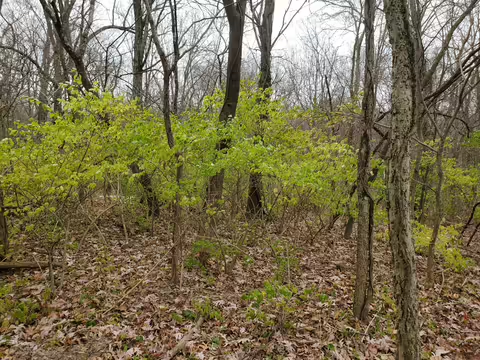Nearly every deciduous plant in the Illinois landscape has lost it leaves for the year, except for one standout.
The non-native, invasive shrubs collectively referred to as bush honeysuckle (Lonicera spp.) have not quite lost them yet, which makes it noticeable this time of year. Its just about the only thing green that’s left in forests.
Now is a great time to remove this plant from your property because it is so noticeable, occurring in woodlands and landscape settings alike. Its easy to see exactly where the work lies and cut-stump herbicide treatments (which are nearly a must for complete control of mature plants) are more effective at this time of year due to the plant process at play right now.
I think that many of us understand why honeysuckle control is important to plant diversity (bush honeysuckle displaces natives and takes over woodlands) but there are other reasons to eradicate this plant from the Illinois landscape as it has drastic effects on many aspects of biodiversity.
Reduced Food Sources
I recently came across a 2018 paper published by researchers in Delaware that explored the relationship between caterpillar abundance and invasive, woody plants like honeysuckle. The study looked at “unmanaged” hedgerows in Delaware agricultural areas, similar to Illinois’ agricultural landscape. By “unmanaged” the authors simply mean that plant composition was not directly or thoughtfully influenced by human intervention and plant species could persist as driven primarily by competition among species.
The study looked at hedgerows with high levels of invasive woody plants and compared them to hedgerows dominated by native species. Bush honeysuckle was just one of 14 invasive species that existed on the study sites, but it was noted as one of the dominate species across all sites, which is the common trend here in central Illinois as well.
Results of the study showed that hedgerows infested with invasives had 68% fewer caterpillar species present and 96% less caterpillar biomass than native-dominated hedgerows. That is a huge difference and illustrates the effect of non-native invasives on our native ecosystems.
In this case, fewer caterpillars (larvae) certainly results in fewer butterflies and moths (adults) but there are other implications for other fauna further up the food chain. When caterpillar biomass is lowered in extreme amounts like this, it has a big impact on bird populations as well since caterpillars remain a staple food for many birds.
Bird migration is a truly fascinating process in and of itself and a little further look into its evolutionary history reveals more on the story of why caterpillar populations are so vital to bird populations. It is simply amazing that animals as small as most migratory birds can make the annual migration over thousands of miles between the Illinois countryside the tropics. How can this possibly be a successful life strategy that evolved in birds?
Since the most recent glacial retreat, the temperate climate here in Illinois offered something the tropics could not. In the springtime, when the plant world begins to awaken from dormancy, there is a similar awakening among insects.
In pursuit of their primary food source (plants), insects emerge in droves to start their lifecycle and maximize the use of our more limited growing season. This results in a nearly inexhaustible food source for anything that eats insects. There simply are not enough predators to consume all the available food (insects) that emerges in concert each spring.
Its this massive food source each spring that draws birds from thousands of miles away, creating a windfall of juicy caterpillars, which is especially important for birds that rear their young on insects. As food resources wane at the close of the growing season, birds return to the tropics for a steady supply over winter.
This great distance of travel also involves great risk for birds. However, the risk of death during migration is outweighed by an increase in offspring fueled by temperate region’s insect emergence each spring. Cornell reports that this pulse of spring food each year allows migratory birds to produce four to six offspring compared to non-migratory relatives that are only able to produce two to three young per year.
As illustrated in the Delaware study, invasives like bush honeysuckle reduce the spring pulse of food by lowering caterpillar numbers. As a result, birds that assume the risk of migration may not receive the associated reward and after years of reduced reproduction, the migratory life they evolved may not payoff any longer.
